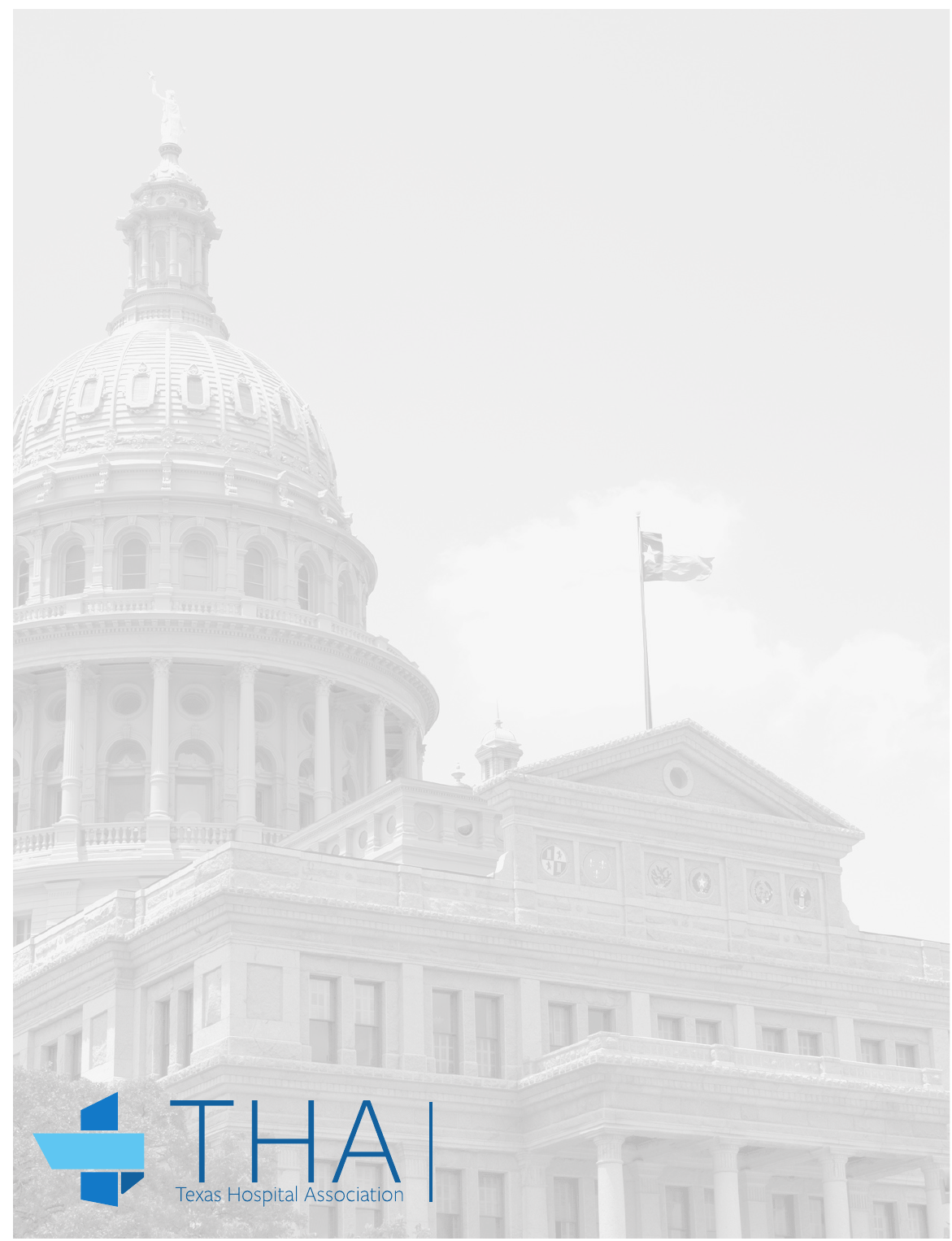
:
Implementing Texas’ New DNR Law :
Hospital and Patient Impact
January 2019

Texas Hospital Association / 1108 Lavaca, Suite 700, Austin, TX 78701-2180 / www.tha.org
THA hosted a summit in October for member hospitals and other stakeholders to discuss
challenges and concerns related to the implementation of Senate Bill 11, passed during
the special legislative session in 2018 and that makes significant changes to physicians’
use of in-hospital do-not-resuscitate orders. The summit is one piece of THA’s advocacy
and education efforts to ensure hospitals fully comply with the law and regulations and
to obtain member input to guide future policymaking work with the Texas Legislature and
rulemaking entities so that patient autonomy and decision-making power are preserved.
Resources for hospitals related to complying with and implementing the new DNR law are
available from www.tha.org/sb11.
Legislative and Regulatory Background
Since the first version of SB 11 was introduced in 2017, THA has worked closely with a broad spectrum of groups, includ-
ing the Texas Medical Association, Texas Catholic Conference of Bishops, Texas Alliance for Life and Texans for Life, to
make sure the bill did not create unnecessary obstacles for patient care or undermine patients’ rights to have their wishes
for end-of-life care respected and upheld. Once it became clear that the authors of SB 11 would not incorporate hospitals’
concerns, THA opposed the bill. Nonetheless, as SB 11 now is law, THA is working with all our members to ensure compli-
ance and to identify areas where the law needs improving to better protect patients’ rights and preserve physicians’ ability
to practice medicine.
SB 11’s provisions took effect April 1 and impose new requirements on hospitals related to issuing, executing, revoking and
providing notice related to a DNR order in an inpatient setting.
Notably, SB 11 sets out a process for in-hospital DNR orders that:
1. Restricts patients from making their wishes known through oral communication with a physician (witnesses must be
present).
2. Outlines, in statute, the confines of a medical order.
3. May allow a surrogate to overrule the wishes of an incompetent patient.
4. Potentially subjects providers and facilities to criminal penalties.
Final rules, issued by the Texas Health and Human Services Commission to guide the implementation of SB 11, took effect
on Sept. 20, 2018. The final rules include changes supported by THA that:
1. Limit the scope of SB 11 to in-hospital DNR orders directing the withholding of CPR performed on a patient whose
circulatory or respiratory functions cease.
2. Allow for an order to be written or electronically uploaded to an EMR.
However, the final rules also exceed the statute’s language and establish requirements for a hospital’s governing body and
medical staff to adopt policies and bylaws formally enacting the facility’s DNR policy in accordance with SB 11. In early
December, the House Committee on State Affairs, chaired by Rep. Byron Cook (R-Corsicana), released its interim charge
report on SB 11. Among its recommendations, it suggests THHSC amend the rules to remove regulations regarding medi-
cal staff bylaws relating to DNR orders.

According to Texas Government Code 305.027, this material may be considered “legislative advertising.” Authorization for its publication is made by John Hawkins, Texas Hospital
Association, 1108 Lavaca, Austin TX 78701-2180. © 2019 Texas Hospital Association. All Rights Reserved.
Medical Perspective
Integral to the discussion about policy that potentially limits patients’ ability to request a DNR order is the medical evidence
on the effectiveness of CPR. Robert Fine, M.D., a medical ethicist at Baylor Scott & White and member of THA’s advance
directives workgroup compiled the following statistics on CPR that demonstrate that CPR outcomes are worse than what is
generally assumed. Nonetheless, it is the default treatment unless a patient has a valid DNR order.
• A sample of CPR use among hospitalized patients nationwide: Survival to discharge averaged about 25 per-
cent of patients, with about 20 percent suffering some type of central nervous system compromise and only about
20 percent of the survivors discharged to home (others were discharged to hospice or nursing or long term care
facilities).
THA Summit on New DNR Law
To help THA members get clarity on implementing the complex legislation, THA convened a summit in October to provide
a forum for members to share questions about the law and to learn from each other and THA staff how best to comply
with the requirements.
While the conversation was wide-ranging, notable concerns with and questions about the legislation focused on issues
where SB 11’s rules and regulations were either 1) unclear and confusing or 2) overly-prescriptive and likely to compromise
patient and physician autonomy. For example:
1. SB 11 requires providers to have conversations with patients and surrogates that were not previously required.
This requirement already has led to situations where an individual does not want to sign a declaration of wishes (as
opposed to only orally relaying those directions to a physician) or did not want to make an oral declaration with
witnesses present. As such, patient autonomy, confidentiality and the physician-patient relationship are potentially
compromised.
2. A lack of clarity resulting from some of SB 11’s rules and regulations requires facilities and physicians to make judg-
ment calls in carrying out their responsibilities, forcing action without clear direction and leading to concerns over
potential penalties. Specific examples include the use of terms such as “as soon as practicable,” “reasonably diligent
efforts,” and “known” individuals (without clarity regarding to whom they must be known) that leave unwanted
room for interpretation, and an unclear delineation on when a facility should issue an order pursuant to SB 11 or
under the rules governing out-of-hospital DNR orders. SB 11’s rules and regulations also reference other provisions
of the Texas Advance Directive Act, such as a citation to Sec. 166.039, without clarity on whether the entire provi-
sion or only subsections are applicable. This lack of clarity creates unclear mandates, confusion and fear for provid-
ers who want comply with a statute that imposes criminal and civil penalties for failing to comply.
3. Under SB 11, an attending physician, defined in regulations as “a physician selected by or assigned to a patient who
has primary responsibility for a patient’s treatment and care,” must direct a DNR order. This requirement can be
challenging in practice in busy hospitals where the attending physician may not be immediately available. This require-
ment could create unnecessary delays and obstacles to having patient wishes respected.
4. Of major concern to hospitals is the ability of a patient’s surrogate decision maker to revoke a proper DNR order
under SB 11. This could allow for a patient’s wishes to be compromised or completely overturned.
THA appreciates the magnitude of the issues raised in response to SB 11’s implementation, and its impact on hospital oper-
ations, physician practice, and most importantly, patient care. THA continues to monitor these issues and guide hospitals
towards best practices.
Implementing Texas’ New DNR Law :
Hospital and Patient Impact

1108 Lavaca, Suite 700, Austin, TX 78701
512.465.1000
www.tha.org
Serving Texas hospitals as the
trusted source and unified voice to
influence excellence in health care
for all Texans.
